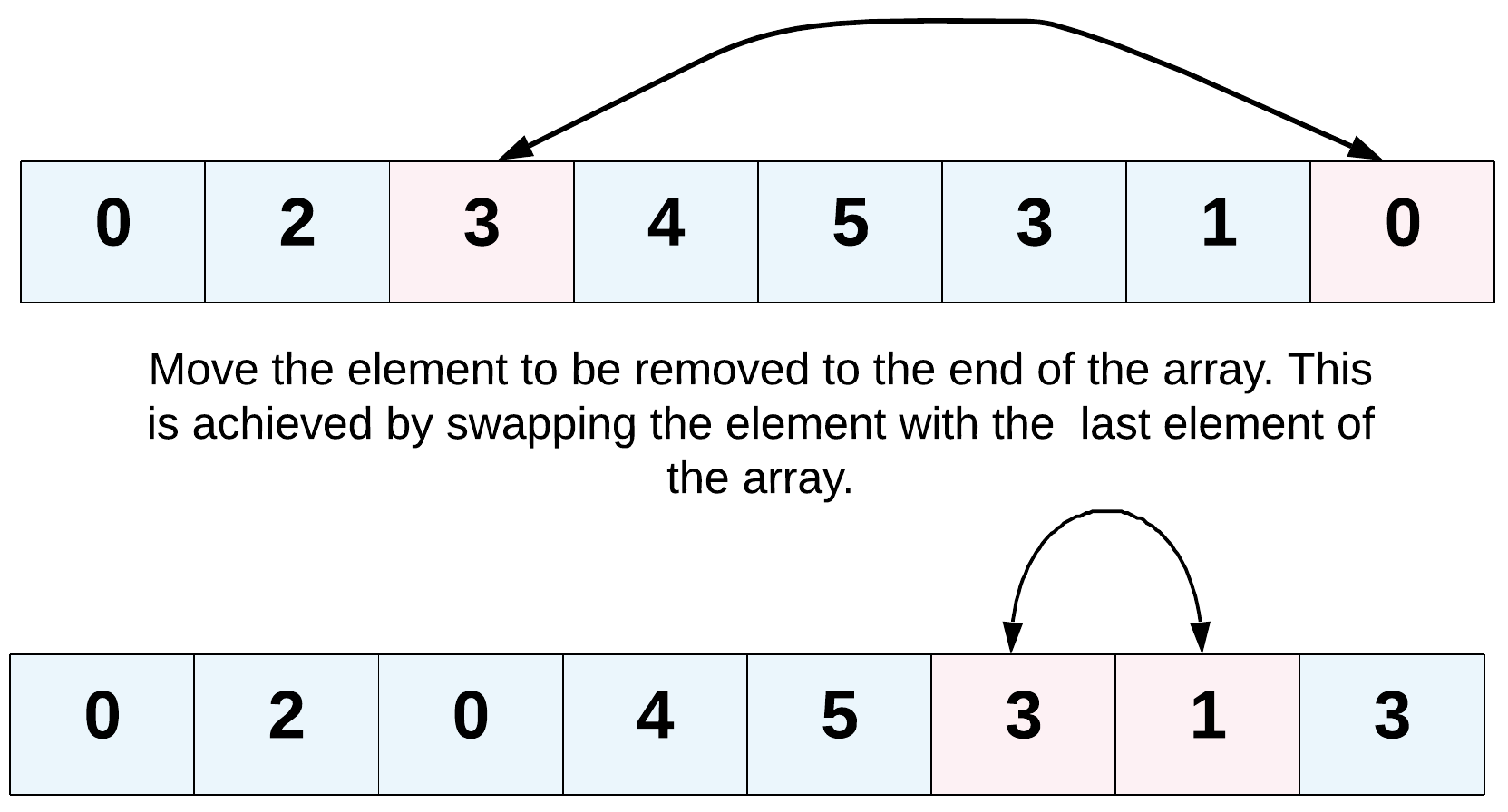力扣链接:27. 移除元素,难度:简单。
给你一个数组 nums 和一个值 val,你需要 原地 移除所有数值等于 val 的元素。元素的顺序可能发生改变。然后返回 nums 中与 val 不同的元素的数量。
假设 nums 中不等于 val 的元素数量为 k,要通过此题,您需要执行以下操作:
- 更改
nums数组,使nums的前k个元素包含不等于val的元素。nums的其余元素和nums的大小并不重要。 - 返回
k。
示例 1:
输入: nums = [3,2,2,3], val = 3
输出: 2, nums = [2,2,_,_]
解释:
你的函数函数应该返回 k = 2, 并且 nums 中的前两个元素均为 2。
你在返回的 k 个元素之外留下了什么并不重要(因此它们并不计入评测)。
示例 2:
输入: nums = [0,1,2,2,3,0,4,2], val = 2
输出: 5, nums = [0,1,4,0,3,_,_,_]
解释:
你的函数应该返回 k = 5,并且 nums 中的前五个元素为 0,0,1,3,4。
注意这五个元素可以任意顺序返回。
你在返回的 k 个元素之外留下了什么并不重要(因此它们并不计入评测)。
约束:
0 <= nums.length <= 1000 <= nums[i] <= 500 <= val <= 100
提示 1
The problem statement clearly asks us to modify the array in-place and it also says that the element beyond the new length of the array can be anything. Given an element, we need to remove all the occurrences of it from the array. We don't technically need to remove that element per-say, right?
提示 2
We can move all the occurrences of this element to the end of the array. Use two pointers!

提示 3
Yet another direction of thought is to consider the elements to be removed as non-existent. In a single pass, if we keep copying the visible elements in-place, that should also solve this problem for us.
思路
双指针,一左一右,左侧的指向数组头部,右侧的指向数组尾部。- 如果发现左侧指针对应的数值等于val,并且右侧指针对应的数值不等于val,就进行值交换。
- 这种手段容易想到,但代码量比起
快慢指针要多。
复杂度
时间复杂度
O(N)
空间复杂度
O(1)
Java #
class Solution {
public int removeElement(int[] nums, int val) {
var left = 0;
var right = nums.length - 1;
while (left <= right) {
if (nums[left] != val) {
left += 1;
continue;
}
if (nums[right] == val) {
right -= 1;
continue;
}
nums[left] = nums[right];
left += 1;
right -= 1;
}
return left;
}
}
Python #
class Solution:
def removeElement(self, nums: List[int], val: int) -> int:
left = 0
right = len(nums) - 1
while left <= right:
if nums[left] != val:
left += 1
continue
if nums[right] == val:
right -= 1
continue
nums[left] = nums[right]
left += 1
right -= 1
return left
C++ #
class Solution {
public:
int removeElement(vector<int>& nums, int val) {
int left = 0;
int right = nums.size() - 1;
while (left <= right) {
if (nums[left] != val) {
left += 1;
continue;
}
if (nums[right] == val) {
right -= 1;
continue;
}
nums[left] = nums[right];
left += 1;
right -= 1;
}
return left;
}
};
JavaScript #
var removeElement = function (nums, val) {
let left = 0
let right = nums.length - 1
while (left <= right) {
if (nums[left] != val) {
left += 1
continue
}
if (nums[right] == val) {
right -= 1
continue
}
nums[left] = nums[right]
left += 1
right -= 1
}
return left
};
C# #
public class Solution
{
public int RemoveElement(int[] nums, int val)
{
int left = 0;
int right = nums.Length - 1;
while (left <= right)
{
if (nums[left] != val)
{
left += 1;
continue;
}
if (nums[right] == val)
{
right -= 1;
continue;
}
nums[left] = nums[right];
left += 1;
right -= 1;
}
return left;
}
}
Go #
func removeElement(nums []int, val int) int {
left := 0
right := len(nums) - 1
for left <= right {
if nums[left] != val {
left += 1
continue
}
if nums[right] == val {
right -= 1
continue
}
nums[left] = nums[right]
left++
right--
}
return left
}
Ruby #
def remove_element(nums, val)
left = 0
right = nums.size - 1
while left <= right
if nums[left] != val
left += 1
next
end
if (nums[right] == val)
right -= 1
next
end
nums[left] = nums[right]
left += 1
right -= 1
end
left
end
其它语言
欢迎贡献代码到我们的 GitHub 仓库,非常感谢!本题解位置在 27. 移除元素。题解2的思路:快慢指针方法
快慢指针方法,指两个指针起初都指向数组头部,后来一个指针走得更快些。- 对于本题,什么情况下需要让快指针走快?就是快指针对应的值等于val时。而慢指针要保证走过的每个值都不等于val。
- 值的交换就发生在快指针对应的值不等于val,慢指针对应的值等于val的时候。
- 这种手段不容易想到,但比
左右双指针技术更简洁。
复杂度
时间复杂度
O(N)
空间复杂度
O(1)
Java #
class Solution {
public int removeElement(int[] nums, int val) {
var slowIndex = 0;
for (var num : nums) { // This line is the most important. You'd better memorize it.
if (num != val) {
nums[slowIndex] = num;
slowIndex += 1;
}
}
return slowIndex;
}
}
Python #
class Solution:
def removeElement(self, nums: List[int], val: int) -> int:
slow_index = 0
for num in nums: # This line is the most important. You'd better memorize it.
if num != val:
nums[slow_index] = num
slow_index += 1
return slow_index
C++ #
class Solution {
public:
int removeElement(vector<int>& nums, int val) {
auto slow_index = 0;
for (auto num : nums) { // This line is the most important. You'd better memorize it.
if (num != val) {
nums[slow_index] = num;
slow_index += 1;
}
}
return slow_index;
}
};
JavaScript #
var removeElement = function (nums, val) {
let slowIndex = 0
nums.forEach((num) => { // This line is the most important. You'd better memorize it.
if (num != val) {
nums[slowIndex] = num
slowIndex += 1
}
})
return slowIndex
};
C# #
public class Solution
{
public int RemoveElement(int[] nums, int val)
{
int slowIndex = 0;
foreach (int num in nums) // This line is the most important. You'd better memorize it.
{
if (num != val)
{
nums[slowIndex] = num;
slowIndex += 1;
}
}
return slowIndex;
}
}
Go #
func removeElement(nums []int, val int) int {
slowIndex := 0
for _, num := range nums { // This line is the most important. You'd better memorize it.
if num != val {
nums[slowIndex] = num
slowIndex += 1
}
}
return slowIndex
}
Ruby #
def remove_element(nums, val)
slow_index = 0
nums.each do |num| # This line is the most important. You'd better memorize it.
if num != val
nums[slow_index] = num
slow_index += 1
end
end
slow_index
end



